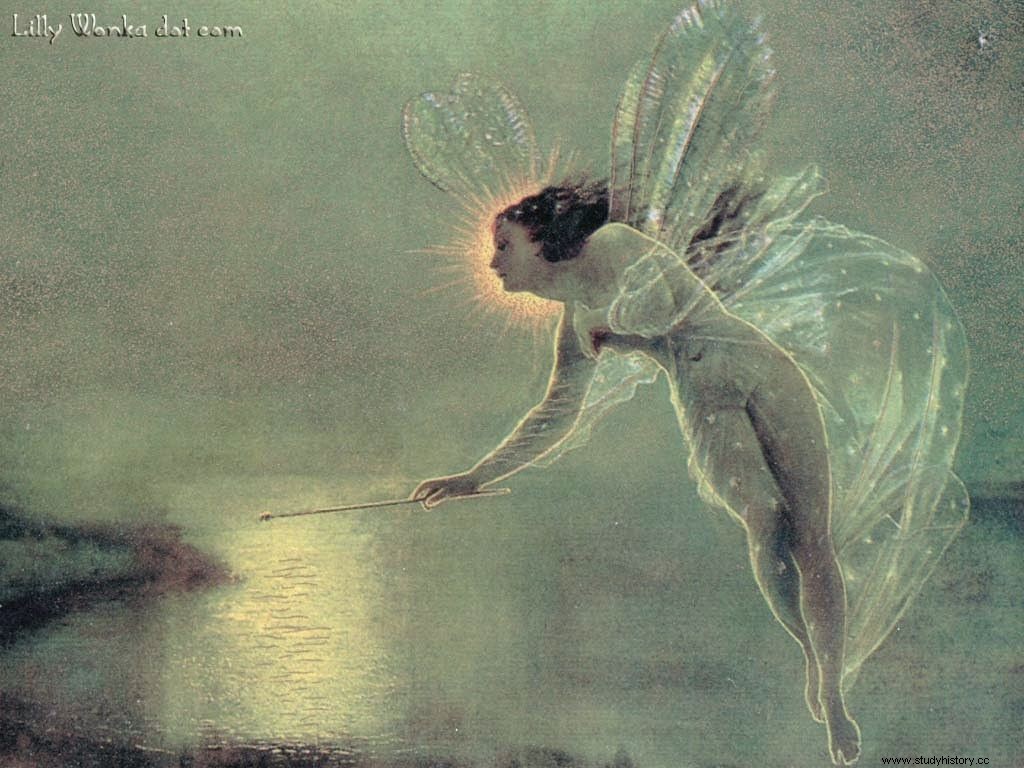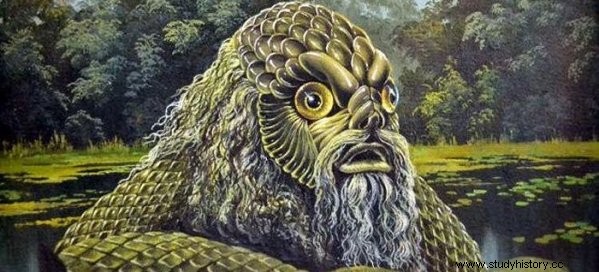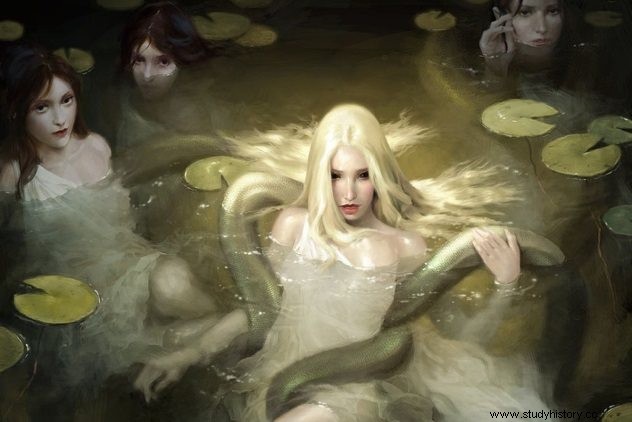Since the beginning of time, we have wondered what is in Water. The seas, as we know, are full of mysteries, but so is the fresh water around us. Rivers, lakes and swamps have many secrets of their own - or so the mythologies of the world say. There are freshwater creatures mentioned in just about every mythology in the world, if not all. While some live in deep lakes and others live under water caves, there are many in between that are just as fascinating. Of course, since this list consists of freshwater animals from mythology and folklore , I would not hold my breath if you would find them in the real world.
If you're wondering what freshwater creatures are found in mythology, look no further. However, this is not an exhaustive list by any means. There are many more freshwater creatures you can find in the ancient folk tales and mythologies, all you have to do is dive into it.
Abaia, Melanesian Mythology

According to Melanesian mythology, a giant eel-like creature called 'Abaia' protects the waters of the islands of Fiji, Vanuatu and Solomon. The eel is said to have magical abilities and watch over the living things in freshwater lakes on the islands. Many believe that Abaia sees the other creatures that live in lakes as fish as their children, which is why it is so protective of them. It is said that Abaia will hit the powerful tail under water if the children are disturbed or injured. This thumping causes a huge wave. The strength of men and even ships is not enough to survive it, and the water brings those who would disturb the lake down into the depths.
Afanc, Welsh mythology

Afanc is a creature from Welsh mythology. It is said to be a demonic creature that may look like a giant beaver, crocodile or dwarf. According to legend, this Welsh creature will attack and eat them to get into the water where it lives. There are various stories about Afanc, including the killing of the creature. A popular version of the Afanc myth comes from Iolo Morgannwg, a bard. In its history, the bard claimed that two long-horned oxen belonging to Hu Gadarn were able to pull the creature from the lake, so that it was killed. An earlier version of the story claimed that the bulls went Afanc to Llyn Ffynnon Las. Due to the lake's deep and rocky shores, the creature was unable to escape and terrorize people again.
Ashrays / Water lovers, Scottish folklore

Scottish folklore is full of aquatic animals and a variety of fascinating creations. Ashrays, or water lovers, can be traced to Scottish mythology. An Ashray can be female or male, and are translucent aquatic creatures. These creatures are nocturnal and are unfortunately confused with sea ghosts. If the asrays come in contact with sunlight, they will melt into a puddle.
Bunyip, Australian Aboriginal Mythology

Australian Aboriginal folklore boasts an unusual creature with a round head, powerful body and long neck. This creature is known as Bunyip. Bunyip is known to live in the lagoons and swamps of Australia, and some accounts of the creature claim that it may also have a human figure. Many will swear that this creature roars or makes a roaring sound. According to legend, women and children are the animal's favorite meal.
Fossegrim, Scandinavian Folklore

If you ever hear the fiddle being played near water Scandinavia, approach with caution. Fossegrim is a troll or water spirit known in Scandinavian folklore. This creature is known for playing beautiful songs on the harding fiddle, and drawing people to its side. It is believed that Fossegrim is related to nixie. He is known as the neck or Strömkarlen in Sweden, which can be translated to 'The River Man'. The waterfall halter is strongly associated with rivers, waterfalls and windmills. He is not known to be dangerous, although you can lose the sense of time when you listen to him play the fiddle. If you have the skills, you can even convince him to learn how to play.
Honey Island Swamp Monster, Louisiana

Everyone knows the legend of Bigfoot, but what if he had a cousin living in a swamp? Since 1963, there have been sightings in Louisiana of a humanoid cryptid known as the Honey Island Swamp Monster. Sources claim that the creature has swimming skin with three toes, which leads many to believe that Bigfoot as we know it has developed nets on its feet over time to withstand the swampy environment. There are also those who worry that the Honey Island Swamp Monster is actually from a scientific experiment that went horribly wrong. Reports of the swamp creation have reached the public as it was featured on Lost Tapes. The documentary claims that the creature attacked a hunter in the swamps.
Jengu, Sawa People / Cameroon Folklore

There are few creatures that have a cult following, and Jengu is lucky enough to have that honor. Located in Cameroon, Jengu or Miengu (plural) is said to resemble a mermaid. They are beautiful, have long hair and charming gap-igniting smiles. This water spirit is an important part of the life of the Sawa people in Cameroon. The Jengu live in rivers and even the sea, and are worshiped by many. They bring happiness to those who worship them and act as healers and mediators between the spirits and people.
The inland group known as Bakweri uses Jengu worship as a rite of passage for young girls. Girls between the ages of eight and ten are traditionally dressed in a suit made of fern leaves and participate in traditional activities. Once the girl has completed the rite of passage, she is welcomed as a true member of the cult.
Jenny Greenteeth, English Folklore

When you think of duck food, you are probably thinking of a plant that lives in a pond. When children in the north-west of England previously saw duck food, they were taught to run. It was said that the presence of duck food in ponds indicated the presence of a far less friendly creature - Jenny Greenteeth. Jenny Greenteeth is a monster, or elf in some records, who lives in ponds full of duck food and drowns children in the depths.
There are many other characters similar to Jenny Greenteeth in English folklore, including Grindylow and Peg o 'Nell. Both of these creatures will behave in the same way and drown both children and the elderly who walk too close to the water's edge. Like many pond dwellers, Jenny Greenteeth reportedly has sharp teeth, long, tousled hair and green skin. When Jenny Greenteeth is not lurking in the water, she probably walks around the branches of the trees at night.
Kappa, Japanese mythology

In Japanese mythology the Kappa lies in the water. Kappa are believed to be freshwater creatures that are vampire-like entities. They are intelligent, but usually do not cause too much trouble for humans. In the legends, Kappa is depicted as the size of a 10-year-old with the physical shape of something resembling a monkey. They have fish shells instead of leather, are yellow-green and carry water in hollow depressions on top of the head. Legend has it that a Kappa will lose their supernatural abilities if they spill water on their heads. Many will trick the creatures into spilling water for their own gain, often by making them bow down. If you're on the bad side of a Kappa, try throwing them a cucumber - they've been known to love fruit.
Mokele-mbembe, Congo Folklore

It is always a question of whether or not dinosaurs are still alive. We often conclude that in addition to creatures such as crocodiles and similar animals, the answer is no. However, the alleged existence of the Mokele mbembe in the Congo Basin may disprove it. The Mokele mbembe is said to be a dinosaur resembling an Apatosaurus. It has a long neck and tail, large body, and is often compared to the Loch Ness monster. The pygmies in the swamp have reported that they hunt the creature for food, although it is difficult since they live in the huge rivers and are believed to live in caves by the river bank.
Rougarou, Cajun Folklore

Werewolf stories have haunted the world for centuries. One such werewolf story comes from Louisiana's swamps. This swamp-dwelling creature has been a source of terror to many who live along the bay in the state, and live in fear. Rougarou has been known to hunt down Catholics who have not observed fasting, as well as poorly behaved children.
Originally, Rougarou was known as loup-garou - the French term for werewolves, although the name over time became as we know it today. Louisiana holds the Rougarou Fest, an annual festival that takes place during the last weekend of October. The fear of Rougarou is real to many because of the creature's roots in Catholicism and Christianity. This creature serves as a reminder to Christians who do not follow the rules of Lent. Legend has it that if a Christian does not fast for seven consecutive years, they themselves will become a Rougarou. This transformation will force them to warn others about the consequences of ignoring fasting for years to come.
Shishiga, Russian folklore

Russian folklore tells stories of a freshwater creature that lives in the swamps. Shishiga, or leshenka, is a female creature known for living in swamps and forests away from towns and villages. She is pale, with long tousled hair and wears all the world. Legends describe her as a unit that harasses those who come too close and are more than happy to bring misfortune to drunkards.
The Lernaean Hydra, Greek and Roman Mythology

Greek and Roman mythology are some of the most famous mythologies in the world. There are stories about creatures so unusual that we can not help but wonder how they came to be. One such creature is Lernaean Hydra, or as many call it, de Hydra. The hydra is known as the offspring of Echidna and Typhon. While Echidna is described as a half female half snake and Typhon a horrible monster with 100 dragon heads, Hydra is a mixture of the two. Hydra lives in the swamps outside Lerna, which is near Argos. Stories describe it as a huge water hose with nine or more heads depending on the sources.
The hydra was known to plague everyone near the bogs, including those in Lerna. Anyone who took the courage to fight the monster would probably die in vain. It was found that when one of the Hydra's heads was cut off, two more grew instead. The fables indicate that the Leni Hydra was eventually killed by the Greek hero Heracles.
Uncegila, Native American mythology

Uncegila is said to have burning eyes and a shrouded mouth. In time, her form became apparent to the world, and she was enormous. Her long body was covered with shells, and protected her from all enemies she could have. She had claws of iron and a voice that sounded like thunder rolling through the vast sky. Anyone who had the misfortune to look at her would slowly go mad or blind. The stories say that in order to kill the horrible creature, a medicine arrow must be aimed at the seventh place in her upper body. The place where her heart is behind the scales.
Vodyanoy, Slavic folklore

Slavic mythology speaks of its own freshwater creation from legend. Vodyanoy is a male water spirit. Czech and German tales have the same creature, although they are called Wassermann or nix, respectively. This creature has a frog-like face with long hair and a green beard. He is always naked even though algae and dirt cover his body. Instead of human hands, he has swimming skin, glowing eyes and the tail of a fish.
Vodyanoy is said to be responsible for drowning in the water where he lives, as well as other incidents. When angry, he can knock out and break dams, drown both animals and humans, and destroy watermills. To stop these things from happening, those who can influence him sacrifice to appease him. Sometimes, instead of killing people, he will take them into the depths to be his slaves and serve him for eternity. In some areas such as the Russian north, legends say that Vodyanoys is ruled by an old man with a club, called Vodyan Tsar. The old man has the ability to sit on clouds and rise to the sky. When he is in heaven, he has the power to form new lakes and rivers.
Conclusion on freshwater creatures

Which freshwater creatures do you feel most attracted to? There are undoubtedly a few creatures you do not want to meet alone at night, but are there any you would like to meet? If you grew up hearing about another freshwater creature that you think will keep people awake at night, share your story. There can never be too many things to be afraid of when walking in the swamps.
